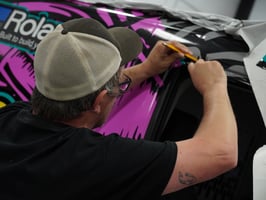How you get your sign supplies is changing, and while it may not affect you now, it could... and...
10 Sign Making Mistakes to Avoid

There's a lot to consider when designing a sign for your customers. Recognizing potential mistakes and avoiding them will give you the best chance at making your customers happy and getting repeat business. Here are the top 10 sign-making mistakes people make and how to avoid them.
Table of Contents
- No Protection
- Improper Design
- Not Accounting for Nature
- Failing to Consider the Climate
- Not Taking Security Measures
- Not Considering the Installation
- Not Thinking About Where the Sign Should Be Placed
- Cost
- Not Checking for Typos and Grammatical Errors
- No Maintenance
1. No Protection
Sun and rain are the real enemies. Just like your skin, your sign needs protection. To avoid fading, it’s a good idea to buy UV inks that are fade resistant, especially if your sign is staying outdoors for more than one day.
Waterproofing outdoor signs is also a good way to protect against rain and winter weather.
2. Improper Design
Typically, someone passing by your customer's sign only has a few seconds to look at it, so it's critical that they can read it clearly.
To enhance sign readability, opt for a font that contrasts with the background. While certain color combinations may look appealing, it is crucial to ensure that the text can be read at a glance. Otherwise, potential customers may drive or walk by without noticing your sign and miss the opportunity for a fantastic first impression.
Additionally, make sure your sign is large enough for people to read at a distance.
3. Not Accounting for Nature
We discussed sun and rain, but other forces of nature pose just as much of a threat. Wind can cause signs to break away from their mounting or even crack a sign in half.
Be sure to make your signs with the right material. They need to be flexible enough to withstand wind. Doing this will save you costly replacements and repairs.
Other solutions include having holes for wind to pass through, or using a mesh-like material.
4. Failing to Consider the Climate
Each substrate reacts differently at different temperatures. Depending on where your sign is located, being able to handle extreme cold or blazing heat can play a part in which material you use to make your sign.
Some materials might become brittle and break or even melt in high heat. Some crack easily in winds or low temperatures. Make your sign with something made for the climate it's predominately going to be in. Check manufacturer guidelines to find out which substrates best suit the climate.
5. Not Taking Security Measures
Another costly mistake is not making your sign anti-theft and easy to clean up. Prevent theft by grounding and bolting down your sign.
Laminates on top of your sign allow graffiti to come off easier, as well as dirt and grime that can accumulate over time.
6. Not Considering the Installation

After choosing the proper substrate, failing to prepare for installation can present other issues. Each material has different factors that can affect travel and installation.
Determine if you need professional installers or not. Always keep in mind how the finished sign will be put up.
7. Not Thinking About Where the Sign Should Be Placed
A sign could have the greatest design, but if it’s not placed in the right spot very few will notice it.
Talk with your customers about where they'd like their signs. Take into consideration any bushes, trees, or other environmental blockades. Find the right spot to get noticed.
Remember, high visibility is key.
8. Cost
Depending on the type of sign you've created, the cost of shipping and installation can make or break the budget. Buying "cheaper" material can also cost more in the long run with repairs, replacements, etc.
Be sure to factor in all costs, from material to installation.
9. Not Checking for Typos and Grammatical Errors

source: pinterest
While designing signs, it is crucial to ensure that the text is error-free. A single typo or grammatical mistake in a sign can create confusion and convey the wrong message to customers. It can also impact the reputation of your shop.
By checking for mistakes before sending out a sign, you are demonstrating attention to detail, professionalism, and respect for your customer's needs. You establish yourself as a trusted partner in their business by delivering an accurate and effective message with your sign.
Take the time to double-check all the text on your signs, even if it might seem tedious. The effort will pay off in terms of customer satisfaction, repeat business, and referrals.
10. No Maintenance
A damaged or poorly maintained sign can give the impression that a business is unprofessional or neglected.
Educate your customers on how they can perform regular maintenance on their sign to help extend its lifespan. It'll save them money in the long run by avoiding costly repairs or replacements.
Some maintenance can't be done by your customers. In that case, as an additional source of revenue, you can offer a maintenance service to your customers where you would clean, repair, or replace a sign when needed.
Maintaining a sign demonstrates a commitment to customer service and satisfaction. When a customer sees that their sign is being taken care of, it can enhance their trust and loyalty to the sign shop.
It's in the best interest of a sign shop to maintain their customer's signs to ensure their own reputation and the satisfaction of their clients.
Follow these tips and you'll save money and have fewer headaches in the long run.




